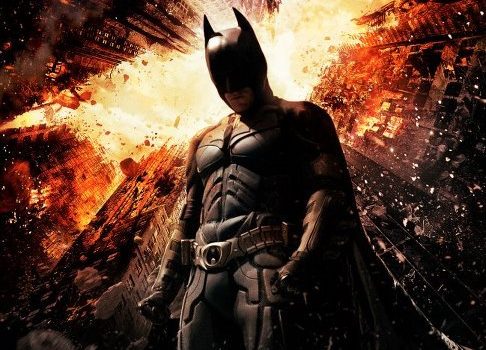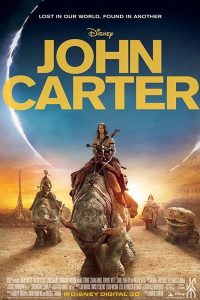Restoring Balance to the World: A Review of The Dark Knight Rises
by Gary Westfahl
 For certain theatre-goers in Aurora, Colorado, as everyone knows, the real world intruded quite unpleasantly into the fantasy world of the film they were enjoying, The Dark Knight Rises, and their tragic experience will inevitably color subsequent critical reactions to the film. Despite some suggestive evidence – the killer dyed his hair like, and identified himself as, “The Joker” – it is far too early to conclude that he was primarily motivated by an obsession with Batman, or that this specific film inspired him to randomly murder some strangers in a movie theatre. (There is a scene in the film where villains begin randomly shooting people in a crowd, at the New York Stock Exchange, but reports indicate that he opened fire well before this occurred.) In a broader sense, though, it is eerily appropriate that his homicidal rampage blighted this particular film, which is all about the real world intruding upon the fantasy worlds of superheroes.
For certain theatre-goers in Aurora, Colorado, as everyone knows, the real world intruded quite unpleasantly into the fantasy world of the film they were enjoying, The Dark Knight Rises, and their tragic experience will inevitably color subsequent critical reactions to the film. Despite some suggestive evidence – the killer dyed his hair like, and identified himself as, “The Joker” – it is far too early to conclude that he was primarily motivated by an obsession with Batman, or that this specific film inspired him to randomly murder some strangers in a movie theatre. (There is a scene in the film where villains begin randomly shooting people in a crowd, at the New York Stock Exchange, but reports indicate that he opened fire well before this occurred.) In a broader sense, though, it is eerily appropriate that his homicidal rampage blighted this particular film, which is all about the real world intruding upon the fantasy worlds of superheroes.
This phenomenon is addressed in a fascinating book I am currently reading, Grant Morrison’s Supergods: What Masked Vigilantes, Miraculous Mutants, and a Sun God from Smallville Can Teach Us about Being Human (2011). This talented comic book writer points out that over the last forty years, a recurring strategy for rejuvenating stagnant superheroes is to drag them into the real world, to force them to confront issues like poverty, racism, and drug addiction in ways that raise fundamental questions about their habits and priorities. Morrison’s own position is clear enough – that superheroes are creations of fantasy worlds, and should generally be allowed to remain within them – but he also acknowledges the aesthetic value of many noteworthy efforts to transplant these modern gods into gritty, realistic situations, and a reviewer with similar views could say the same thing about The Dark Knight Rises; for it is a magnificent, resonant film that does not deserve to be forever linked to a crazed assassin.
But this film’s Bane (Tom Hardy) is also a different sort of super-villain, and that makes this film a different sort of superhero epic. True, the character sometimes recalls earlier foes of Batman in his tendency to indulge in portentous speechifying, and he will occasionally crack a joke or two. Still, he generally carries out his lethal agenda in a grimly businesslike fashion; he evidences no desire to be theatrical, in that his face mask is there for a purely practical reason – to ease his constant pain – and he otherwise seems to pay little attention to what he is wearing; and while he advances various reasons behind his actions, it ultimately emerges that he is primarily working as a criminal for hire, doing the bidding of others, and his main personal motivation seems to be unrequited love. All of this strongly contrasts with his immediate predecessor, Heath Ledger’s Joker in The Dark Knight (2008) (review here), who also killed a lot of people but at least seemed to be enjoying himself. For Bane, being evil is a job, not an obsession, and his brutal efficiency in seizing control of Gotham City is starkly at odds with the elaborate, even playful schemes of previous villains in Batman films. It is little wonder, then, that the film’s other villain, the more traditional Catwoman (Anne Hathaway), confesses to being afraid of Bane, since this implausibly poised, elegant, and wisecracking woman recognizes that he is entirely different from the character’s earlier partners in crime. (Indeed, since his black mask and mechanically distorted voice seem designed to recall Star Wars’ Darth Vader, there is even the suggestion that he represents an alien invader in Batman’s world.)
And how does Batman (Christian Bale) respond to this new sort of opponent? At first, he seems unable to overcome such an unrelenting foe, and not simply because he has been out of action for eight years. (“It takes a little while to get back into things,” remarks Alfred [Michael Caine].) Easily outwitted by the vivacious Catwoman, he is viciously assaulted by Bane, who (as in the comic book stories that introduced him) breaks his back at the end of a one-sided battle and exiles him to a remote African prison. Batman responds to this unprecedented defeat in two ways. First, this obsessed individual becomes even more obsessed with improving himself so that he can deal with this unwelcome intruder: he works his way back into superb physical condition, he escapes from the prison, and with some help from the resourceful Lucius Fox (Morgan Freeman), he obtains the technological tools that, along with his strengthened physique, will allow him to overcome Bane. (Given the proclivities of Hollywood blockbusters, the fact that the film does not end with Bane triumphant can hardly be regarded as a “spoiler.”) Second, he seemingly resolves that his struggle with Bane will be Batman’s final adventure, to be followed by either his death or his retirement. (Since the film’s tagline is “The Legend Ends,” this isn’t really a spoiler either.) Clearly, this wondrous figure of fantasy does not wish to continue his career in a world that includes individuals like the brusquely ruthless Bane – and in light of what he endures during the film, one cannot blame him for this decision.
Some intimations of unpleasant realities in this film are impossible to ignore, like the massive explosions throughout the city that recall, yet again, the September 11 attacks. (And the Batman films no longer bother to conceal that their fictional Gotham City is really New York City, since one scene displays its iconic store, Saks Fifth Avenue.) In a subtler touch referencing the financial crises of recent years, Batman is initially undone not by a physical attack but economic sabotage, as Bane employs copies of Bruce Wayne’s fingerprints to engage in risky investments that decimate the multi-millionaire’s enormous fortune. The quest of justice is also stymied by bureaucratic infighting involving Commissioner Gordon (Gary Oldman), police chief Foley (Matthew Modine), and Mayor Garcia (Nestor Carbonell) that delays an early effort to find Bane’s headquarters. And for a few attentive viewers, casting William Devane in a cameo role as the President of the United States is significant, because this actor first rose to prominence by playing another president, John F. Kennedy, in a television movie, The Missiles of October (1974), about the Cuban missile crisis – the last time the United States faced the real prospect of nuclear bombs destroying American cities, and a reminder that the film’s dreaded explosion of a nuclear weapon in a thinly disguised New York City remains a real possibility.
The Dark Knight Rises, though, does not merely reflect the real world, but also offers a recommendation about the real world that interestingly conflicts with what the talking heads on television are undoubtedly saying about the Aurora massacre. Inevitably, such tragedies inspire calls for new laws and policies designed to prevent anything like this from ever happening again, so it is easy to anticipate calls for, say, metal detectors and security guards at movie theatres, heightened scrutiny of troubled students by university administrators, restrictions on excessive purchases of guns and ammunition, harsher penalties to deter potential assailants, and/or new efforts to suppress, or limit access to, violence in the media. Yet this film specifically warns against overreactions to spectacular crimes. For in response to the Joker’s reign of terror in The Dark Knight, Gordon corruptly resolved to conceal the fact that crusading attorney Harvey Dent (Aaron Eckhart, briefly observed here in footage from the previous film) had turned into an insane criminal and instead allowed officials to employ his purported heroic martyrdom to successfully push for passage of the draconian Dent Act. (Apparently, Gotham City is now not only a city but a sovereign state, since it passes its own criminal laws and issues its own license plates, as observed on cars in the film.) The Dent Act’s provisions then enabled Gotham City to crack down on crime by essentially putting all of its criminals in jail and throwing away the key – which in turn provides Bane with a powerful justification for his takeover of the city. In one gripping scene, he reads to the world an undelivered speech by Gordon revealing this deception, and he announces his resolve to correct the resulting injustice by freeing all of the unfairly incarcerated prisoners at Blackgate Prison. When one observer mutters that all of those men were “denied parole based on the Dent Act,” he implies that Bane indeed has a point, and that when the released criminals then go after police officers and officials, they are being partially driven by an understandable righteous indignation. And as the film concludes, no one is talking about passing any new laws because of Bane’s reprehensible actions.
However, while civil libertarians might applaud the film’s warning against overly harsh laws, the film also presents another solution to the problem of crime that is almost inescapable in superhero films – since it functions to vindicate the very existence of superheroes – but is distressing as a policy recommendation. This is the argument eventually embraced by Gordon’s assistant, detective John Blake (Joseph Gordon-Levitt), that in efforts to combat criminals, “structures” are “becoming shackles,” so committed crime fighters must work outside the law to be fully effective. Thus, emulating another dedicated police officer who became disillusioned with the justice system, Clint Eastwood’s Dirty Harry (1971), Blake dramatically throws away his badge and quits the force, manifestly determined to continue his battle against crime unhindered by the “shackles” imposed by society. Still, while this system works well enough when the vigilante is a fanatically moral figure like Batman, who restrains Catwoman in a battle by insisting “no guns, no killing,” one cannot forget (to mention another well-publicized crime) that another individual, George Zimmerman, also concluded that the police were ineffectual and that he needed to fight crime all by himself, and we all know how well that turned out.
As if cognizant of the problem, The Dark Knight Rises does offer some arguments against vigilante justice, well articulated by one of the film’s most appealing characters, Caine’s Alfred (still the finest butler Batman has ever had). When Batman returns from his first battle against Bane, Alfred remarks that his master has not lost his “taste for wanton destruction,” archly insinuating that having a superhero in one’s city can result in a lot of expensive collateral damage. He also notes that Batman’s intervention might have been more a damaging distraction than a boon, since Foley abandons his pursuit of Bane in order to follow another wanted criminal, Batman. Determined to prevent Batman from returning to his costumed career and endangering his life, he also suggests, reasonably enough, that the wealth and resources of Bruce Wayne might be far more efficacious in improving society than the colorful exploits of Batman – as is also conveyed by Wayne Enterprises board member (and romantic rival to Catwoman) Miranda Tate (Marion Cotillard), who says that “You have to invest if you want to restore balance to the world.” Unwilling to resolve the issue in a manner that would totally invalidate its titular character, this film, like its predecessor, falls back on a limited defense of vigilantism based on exceptional cases: in ordinary circumstances, ordinary law enforcement is sufficient, but extraordinary initiatives are required in response to extraordinary circumstances – like a madman holding an entire city hostage with a nuclear bomb.
In addition, like most of the Batman stories that feature Catwoman, there is the suggestion that obsessed crime fighters are actually attracted to the idea of committing crimes, and choose their profession primarily in order to associate with criminals. Here, Batman’s strong attraction to the duplicitous Catwoman, and continuing willingness to trust her despite repeated betrayals, convey that he might be happy enough to join her on the wrong side of the law. And without revealing any specifics about the ending, one notices that, by the end of the film, Batman has in fact committed at least two crimes that have put actual individuals in prison. True, Batman could say that it was all for the best, but altruistic motives are not an acceptable defense in a court of law.
Finally, for anyone who bothers to notice it, the film also includes a very old, and very lame, message about science that Hollywood never tires of embedding within what it regards as science fiction films: scientific progress is bad, and it both can be permanently suppressed and should be permanently suppressed. Here, the undesirable advance is a fusion reactor developed by Wayne Enterprises that can serve as a wonderful new source of energy; however, since it can also be transformed into a nuclear bomb, Wayne insists that it can never be turned on. And when Bane does exactly what Wayne feared, his actions cannot be undone, because Bane has killed the only scientist in the world, Dr. Pavel (Alon Aboutboul), who can figure out how to deactivate the bomb. It seems pointless to complain about the dubious logic behind all of this, or to observe that nothing about the film would have been changed if it concluded with an announcement that scientists had figured out how to prevent any future misuse of these devices, and that Gotham City could soon deal with its crime problem by providing all of its citizens with cheap, abundant energy and hence could eliminate many of the motives for criminal activity. For these irrational attitudes toward science are so deeply engrained in the zeitgeist of the industry that director Christopher Nolan and the other screenwriters were probably not even aware that they were echoing them.
Influenced by a singular tragedy, one might be overly inclined to draw public policy recommendations out of what is basically an escapist fantasy film, and The Dark Knight Rises also drops one powerful hint that all of its antics should not be taken too seriously. For Bane elects to unveil his sinister plans for Gotham City at a local football game pitting the Gotham Rogues against the Rapid City Monuments, and after proclaiming that his actions signal “the next era of western civilization,” he seems to back away from this grandiose claim by saying, “Let the games begin.” The point seems clear enough: the Gotham Rogues are the film’s bad guys; the Rapid City Monuments, referencing the four iconic presidents immortalized on Mount Rushmore, are the good guys; and they are battling against each other on a special field that is separated from, and unrelated to, the real world. And just as no one would base an actual battle plan on the maneuvers of football players, no one should implement any anti-crime initiatives based on the actions of Batman, Bane, and their allies. (Football fans might also enjoy the scene because of another playful touch, its use of actual members of the Pittsburgh Steelers to play the Gotham Rogues, including quarterback Ben Roethlisberger and former coach Bill Cowher.) This scene should be remembered by any commentators who are tempted by the bizarre crimes of a deranged man to condemn this film as a glorification of violence, or incitement to violence, in the same manner that Fredric Wertham notoriously condemned comic books and others have condemned television and video games. The Dark Knight Rises is a game; it is a well-played and quite entertaining game; and we should not allow James Holmes to prevent us from enjoying the game. And keeping this firmly in mind will indeed enable us to restore balance to the world.









This isn’t a comment on your review but a hint of purpose on the aurora shootings and some of the previous mass shootings. I quote ‘The Joker’ here….”Upset the established order and create chaos. Oh and you know the thing about chaos, it’s fair.” Mr Holmes isn’t crazy, the world is and a few people like him are taking notice ( I’m not condoning his actions BTW). After all these shootings, people first start shouting gun control but there are so many more powerful weapons that can never be controlled -subtle, insidious weapons!